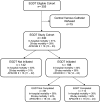Factors associated with nonadherence to early goal-directed therapy in the ED
- PMID: 20173053
- PMCID: PMC2939882
- DOI: 10.1378/chest.09-2210
Factors associated with nonadherence to early goal-directed therapy in the ED
Abstract
Background: Protocol-driven early goal-directed therapy (EGDT) has been shown to reduce mortality in patients with severe sepsis and septic shock in the ED. EGDT appears to be underused, even in centers with formalized protocols. The aim of our study was to identify factors associated with not initiating EGDT in the ED.
Methods: This was a cohort study of 340 EGDT-eligible patients presenting to a single center ED from 2005 to 2007. EGDT eligibility was defined as a serum lactate >or= 4 mmol/L or systolic BP< 90 mm Hg after volume resuscitation. EGDT initiation was defined as the measurement of central venous oxygen saturation via central venous catheter. Multivariable logistic regression was used to adjust for potential confounding.
Results: EGDT was not initiated in 142 eligible patients (42%). EGDT was not completed in 43% of patients in whom EGDT was initiated. Compliance with the protocol varied significantly at the physician level, ranging from 0% to 100%. Four risk factors were found to be associated independently with decreased odds of initiating EGDT: female sex of the patient (P = .001), female sex of the clinician (P = .041), serum lactate (rather than hemodynamic) criterion for EGDT (P = .018), and nonconsultation to the Severe Sepsis Service (P < .001).
Conclusions: Despite a formalized protocol, we found that EGDT was underused. We identified potential barriers to the effective implementation of EGDT at the patient, clinician, and organizational level. The use of a consultation service to facilitate the implementation of EGDT may be an effective strategy to improve protocol adherence.
Figures
Comment in
-
Point: adherence to early goal-directed therapy: does it really matter? Yes. After a decade, the scientific proof speaks for itself.Chest. 2010 Sep;138(3):476-80; discussion 484-5. doi: 10.1378/chest.10-1405. Chest. 2010. PMID: 20822986 No abstract available.
Similar articles
-
Translating research to clinical practice: a 1-year experience with implementing early goal-directed therapy for septic shock in the emergency department.Chest. 2006 Feb;129(2):225-232. doi: 10.1378/chest.129.2.225. Chest. 2006. PMID: 16478835
-
Implementing a collaborative protocol in a sepsis intervention program: lessons learned.Lung. 2011 Feb;189(1):11-9. doi: 10.1007/s00408-010-9266-z. Epub 2010 Nov 16. Lung. 2011. PMID: 21080182
-
Evaluation of a modified early goal-directed therapy protocol.Am J Emerg Med. 2010 Jul;28(6):689-93. doi: 10.1016/j.ajem.2009.03.007. Am J Emerg Med. 2010. PMID: 20637384
-
The Effect of Early Goal-Directed Therapy on Outcome in Adult Severe Sepsis and Septic Shock Patients: A Meta-Analysis of Randomized Clinical Trials.Anesth Analg. 2016 Aug;123(2):371-81. doi: 10.1213/ANE.0000000000001278. Anesth Analg. 2016. PMID: 27049857 Free PMC article. Review.
-
[Early goal directed therapy in severe sepsis].Med Klin Intensivmed Notfmed. 2014 Nov;109(8):568-76. doi: 10.1007/s00063-014-0377-9. Epub 2014 Sep 28. Med Klin Intensivmed Notfmed. 2014. PMID: 25261188 Review. German.
Cited by
-
Using quality improvement principles to improve the care of patients with severe sepsis and septic shock.Ochsner J. 2013 Fall;13(3):359-66. Ochsner J. 2013. PMID: 24052765 Free PMC article.
-
Patient, provider, and environmental factors associated with adherence to cardiovascular and cerebrovascular clinical practice guidelines in the ED.Am J Emerg Med. 2018 Aug;36(8):1397-1404. doi: 10.1016/j.ajem.2017.12.062. Epub 2017 Dec 29. Am J Emerg Med. 2018. PMID: 29402689 Free PMC article.
-
Epidemiology and outcomes in patients with severe sepsis admitted to the hospital wards.J Crit Care. 2015 Feb;30(1):78-84. doi: 10.1016/j.jcrc.2014.07.012. Epub 2014 Jul 22. J Crit Care. 2015. PMID: 25128441 Free PMC article.
-
Effect of specialty and recent experience on perioperative decision-making for abdominal aortic aneurysm repair.J Am Geriatr Soc. 2012 Oct;60(10):1889-94. doi: 10.1111/j.1532-5415.2012.04157.x. Epub 2012 Sep 27. J Am Geriatr Soc. 2012. PMID: 23016733 Free PMC article.
-
Use of femoral vein catheters for the assessment of perfusion parameters.Rev Bras Ter Intensiva. 2013 Apr-Jun;25(2):168-74. doi: 10.5935/0103-507X.20130029. Rev Bras Ter Intensiva. 2013. PMID: 23917983 Free PMC article. Review.
References
-
- Angus DC, Linde-Zwirble WT, Lidicker J, Clermont G, Carcillo J, Pinsky MR. Epidemiology of severe sepsis in the United States: analysis of incidence, outcome, and associated costs of care. Crit Care Med. 2001;29(7):1303–1310. - PubMed
-
- Rivers E, Nguyen B, Havstad S, et al. Early Goal-Directed Therapy Collaborative Group Early goal-directed therapy in the treatment of severe sepsis and septic shock. N Engl J Med. 2001;345(19):1368–1377. - PubMed
-
- Trzeciak S, Dellinger RP, Abate NL, et al. Translating research to clinical practice: a 1-year experience with implementing early goal-directed therapy for septic shock in the emergency department. Chest. 2006;129(2):225–232. - PubMed
-
- Gaieski DF, McCoy J, Zeserson E, et al. Mortality benefit after implementation of early goal directed therapy protocol for the treatment of severe sepsis and septic shock. Ann Emerg Med. 2005;46(3):4.
-
- Shapiro NI, Howell MD, Talmor D, et al. Implementation and outcomes of the Multiple Urgent Sepsis Therapies (MUST) protocol. Crit Care Med. 2006;34(4):1025–1032. - PubMed
Publication types
MeSH terms
Grants and funding
LinkOut - more resources
Full Text Sources
Other Literature Sources
Medical


